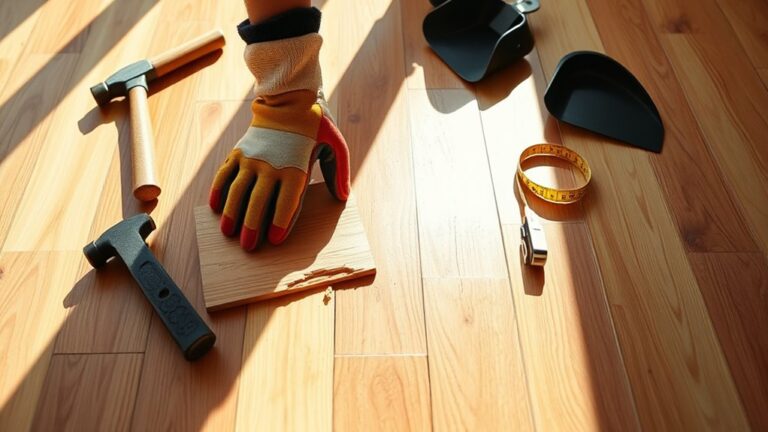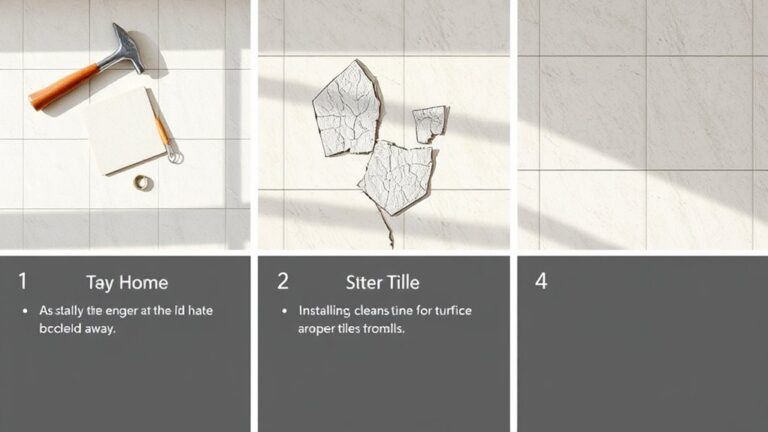When choosing wheelchair-friendly flooring, focus on stability and slip resistance. You'll want surfaces that are firm, smooth, and able to handle the weight and movement of a wheelchair. Ideal options include textured tiles, commercial-grade vinyl, and rubber flooring for high-traffic areas. Avoid thick carpets, loose rugs, and foam tiles, as they can obstruct movement. Remember to check for minimal height differences, ideally under 1/4 inch. Proper installation and maintenance are essential for safety and longevity. If you're looking for more detailed guidance on selecting the best materials and installation tips, there's plenty more to explore.
Understanding ADA Compliance
When choosing flooring for wheelchair accessibility, understanding ADA compliance is vital. The Americans with Disabilities Act (ADA) outlines specific requirements to guarantee safe and efficient navigation for individuals using wheelchairs. First and foremost, your flooring must provide a stable surface. This means avoiding uneven or fluctuating areas that can hinder movement and create safety hazards.
Slip resistance is another important factor, especially in moisture-prone areas. By opting for textured flooring, you enhance traction and reduce the risk of slips. This not only makes your space safer but also promotes independence for wheelchair users, allowing them to move freely without fear of falling.
You also need to be aware of flooring changes. According to ADA guidelines, the vertical height differences in these changes should not exceed 1/4 inch. For differences between 1/4 and 1/2 inch, beveled changes are required to guarantee a smooth change from one surface to another. Smooth flooring options are ideal since they facilitate easy wheelchair navigation, minimizing the effort needed to move through your space.
Ideal Flooring Characteristics
Selecting the right flooring for wheelchair accessibility involves key characteristics that guarantee both safety and functionality. You want a surface that's stable, firm, and smooth to guarantee easy navigation and prevent accidents. It's essential that the flooring can withstand the weight and movement of wheelchairs, which means durability is important.
Here's a quick reference table to visualize the ideal flooring characteristics:
| Characteristic | Description |
|---|---|
| Stability | Firm and smooth surfaces for easy navigation |
| Slip Resistance | Textured options in moisture-prone areas for traction |
| Durability | Long-lasting materials that handle weight |
| Change | Minimal height differences, ideally under 1/4 inch |
Slip resistance is important, especially in areas exposed to water. Textured surfaces provide the needed traction, reducing risk while enhancing freedom of movement. Additionally, changes between different rooms should be seamless; you don't want to face obstacles that could hinder mobility.
Lastly, choose flooring that's easy to maintain. Long-lasting materials should not only remain functional but also visually appealing over time, allowing you to enjoy your space without constant upkeep. By focusing on these characteristics—stability, slip resistance, durability, and easy maintenance—you'll create an environment that truly supports freedom and accessibility.
Recommended Flooring Options
Finding the right flooring for wheelchair accessibility can greatly enhance mobility and safety in your space. When considering options, you'll want to prioritize durability, slip resistance, and ease of installation.
Tile flooring is a solid choice, especially smaller, textured ceramic or porcelain tiles that improve slip resistance and stability. Recommended options like RevoTile and Daltile Season Wood are ideal for wheelchair users. If you prefer a smoother surface, vinyl flooring, particularly commercial-grade SPC and WPC varieties like COREtec Pro Plus and Adura Max Apex, offer a low-maintenance and water-resistant solution.
Rubber flooring is another excellent option, providing outstanding slip resistance and impact absorption. Products like 3/8 Heavy Duty Rubber Rolls excel in high-traffic areas, ensuring safety for wheelchair operation.
If you're considering carpet, opt for low-pile carpet that doesn't exceed 1/2 inch in thickness. Short fibers will better support wheelchair movement, making commercial-grade varieties the preferred choice.
Finally, laminate flooring is a great alternative, combining aesthetics with functionality. Durable options such as Rembrant Oak and Nimrod Stone Herringbone come with click systems for easy installation and can withstand the demands of wheelchair traffic.
These recommended options not only promote wheelchair accessibility but also contribute to a stylish and functional living environment. By selecting the right flooring, you can create a space that fosters freedom and independence.
Flooring Types to Avoid
While there are many flooring options that enhance wheelchair accessibility, it's just as important to recognize which types to avoid. When selecting flooring, you'll want to steer clear of flooring types that can hinder your mobility and create unnecessary challenges.
Thick carpets may seem comfortable, but they can damage wheelchair wheels and greatly impede your movement. High-pile carpets fall into the same category; their plushness can severely limit wheelchair traction, making navigation difficult. Loose rugs are another flooring type to avoid, as they can slide or bunch under your wheelchair, creating tripping hazards that can compromise your safety.
Peel-and-stick flooring might seem like an easy solution, but this type can loosen over time, resulting in uneven surfaces that obstruct your path. Similarly, foam tiles, while often marketed for comfort, can compress and separate, leading to blockages that can hinder your mobility and create safety concerns.
Ultimately, the goal is to guarantee safe navigation and freedom of movement in your space. By avoiding these flooring types, you can create an environment that enhances your independence and allows you to move with confidence. Emphasizing the importance of choosing the right flooring will help you avoid potential obstacles and enjoy a more accessible living space. Make informed choices, and you'll be on your way to a smoother, more enjoyable experience.
Installation and Maintenance Tips
When it comes to installing wheelchair-friendly flooring, a few key tips can make a significant difference in both performance and longevity. To guarantee you achieve the best results, consider the following:
- Professional Installation: For complex flooring types, hiring a professional is recommended. They guarantee proper fitting and adherence to safety standards, which can also include warranties for added peace of mind.
- Subfloor Preparation: A clean and level subfloor is essential. Make sure to address any moisture issues by using barriers, which will extend the longevity of your flooring materials.
- Acclimation: Allow your flooring materials to acclimate to the room's temperature and humidity levels before installation. This step helps prevent warping and buckling, guaranteeing durability.
- Regular Maintenance: Once installed, commit to regular maintenance. Easy cleaning and periodic inspections for wear will enhance safety and prolong the lifespan of your flooring.
Frequently Asked Questions
What Type of Flooring Is Best for Wheelchair Users?
When considering the best flooring for wheelchair users, think about accessible design and durability factors. High-quality vinyl and slip-resistant tiles excel in maintenance and cost comparison. They offer great aesthetic appeal while ensuring sound insulation and environmental impact are also addressed. During installation, keep an eye on elevation changes to maintain safety. Opt for flooring materials that withstand wear and tear, providing both freedom of movement and peace of mind.
Will a Wheelchair Damage Vinyl Plank Flooring?
A wheelchair shouldn't damage vinyl plank flooring if you choose high-quality options. With excellent flooring durability and a stable surface texture, it can handle wheelchair weight effectively. Just make sure to evaluate maintenance requirements to prolong its life and enjoy noise reduction and slip resistance benefits. Plus, the cost-effectiveness and aesthetic appeal make it a smart choice for long-term wear. Proper installation methods are key to maximizing its performance under heavy use.
What Laminate Flooring Is Wheelchair Friendly?
When considering laminate flooring that's wheelchair-friendly, focus on laminate durability and slip resistance. Look for texture options that provide a smooth surface, and consider eco-friendly choices for sustainability. Installation tips include choosing products with a click system for easier setup. Additionally, design aesthetics can match your style, while maintenance requirements are generally low. Keep cost considerations in mind, as investing in quality guarantees long-term performance and sound absorption for a comfortable environment.
Is Vinyl Good for Wheelchairs?
When it comes to steering through your space, vinyl flooring's like a trusted companion—it offers durability and slip resistance that enhances wheelchair maneuverability. With a smooth texture variety, it minimizes friction, making movement effortless. Its easy installation saves time while providing a range of design options for your personal style. Plus, you'll appreciate its cost-effectiveness, minimal noise reduction, and low environmental impact, ensuring your home feels both welcoming and functional.




